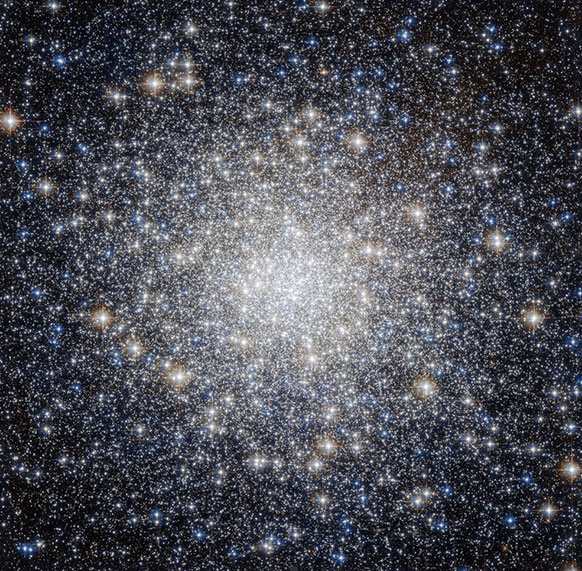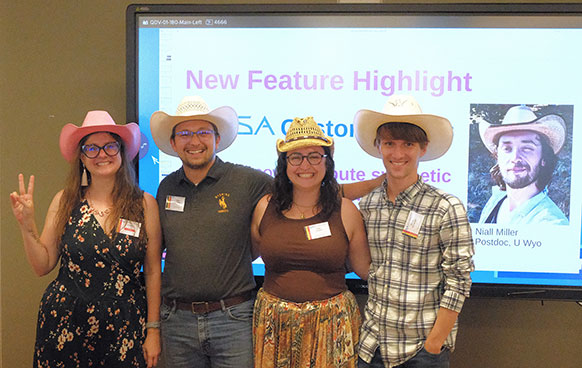UW Professor Joyce Receives Grant Set to Re-Write History of the Stars
Published October 10, 2025

Messier 92, a globular cluster that is about the same age as the universe, is shown in this image taken with the Hubble Telescope. (Gilles Chapdelaine NASA/European Space Agency Photo)
How old are the stars? Even with the most accurate tools currently available for modeling
stellar evolution, the answer sometimes comes back, “older than the known universe.”
Clearly, something’s not adding up, and Meridith Joyce has made it her mission to
find out where the error lies.
Joyce, an assistant professor in the Department of Physics and Astronomy and School
of Computing at the University of Wyoming, is one of the core developers of the Modules
for Experiments in Stellar Astrophysics (MESA) software suite, widely regarded as
the top program for modeling stellar evolution and one of the most widely used software
tools in all of astronomy. MESA, in turn, is used to produce isochrones, or visualizations
used to estimate the age of stars and star clusters.
With the help of a newly received $299,999 grant from the EPSCoR (Established Program
to Stimulate Competitive Research) Research Fellows program of the National Science
Foundation, Joyce will make a revised set of models based on MESA Isochrones and Stellar
Tracks, a database of isochrones that includes more specific information about convection,
informed by observations of real stars. Taking variations in convection into account
is important because the treatment of convection can have a large impact on the fundamental
stellar parameters derived from models, rather than direct observation, including
mass, evolutionary stage and age.
“The star we understand best is the sun. It’s the one we’re nearest to. It’s the one
we have the best observations of. And, so everyone’s just been like, OK, let’s just
assume that everything acts the way that it does in the sun,” Joyce says. “We now
know from these space-based observatories that things do not act the way that they
act in the sun necessarily. But no one has actually taken that into account in designing
new models. Doing so requires a lot of computational resources, and now that I’m at
Wyoming ARCC (Advanced Research Computing Center), and there’s the opportunity to
use NCAR (National Center for Atmospheric Research-Wyoming Supercomputing Center),
these resources do exist now to address this problem.”
Joyce will partner with Philip Mocz, the lead software engineer at MESA, to receive
training for herself and UW graduate student Eliza Frankel at the Center for Computational
Astrophysics (CCA) at the Flatiron Institute in New York. Between the computing power
and support from the CCA and the UW School of Computing, Joyce says that, for the
first time, a solution to one of the biggest anomalies in astrophysics is within reach.
“It’s uniquely beneficial to be in Wyoming, where we have this high-performance computer
… and the CCA has a ton of computational resources as well. So, this is sort of the
first time that it’s actually been feasible,” Joyce says of attempting to correct
historical assumptions based on prior oversimplifications in the modeling.

UW Assistant Professor Meridith Joyce, left, attends the MESA Summer School in Belgium with astronomy Ph.D. students Caleb Eastlund, Eliza Frankeland and Josh Wanninger. Postdoctoral researcher Niall Miller is pictured on the screen. (Mathijs Vanrespaille Photo)
“I am intimately familiar with all of these kinds of poor approximations that we’re
making,” she adds. “But then it’s like, OK, well, what can we actually do to improve
this? And only really with this space-based observing revolution have we been able
to see that maybe the way that we’re modeling convection in these stars is not appropriate.
And that’s something that can only really have been discovered with the observational
advances that we’ve had over the last 10 or 20 years.”
Joyce’s team will apply the new model it develops, dubbed MISTiC (MIST including convection),
to update the known ages of over 150 globular clusters, leading to a better understanding
of the early evolution of the universe.
In addition to funding access to invaluable computing resources to provide more accurate
estimates of the true age of stars, the grant, titled “Unraveling Cosmological Tensions
by Modeling the Oldest Stars with Improved Treatments of Convection in Stellar Interiors,”
will bring a high-profile astrophysics program to Wyoming for the first time.
The MESA Summer School has a 15-year history but, for the past several years, it has
been hosted overseas. Next year will mark the return of the program to the United
States, bringing valuable international recognition to astronomy and astrophysics
at UW. Despite not yet officially announcing the program, Joyce already is taking
a wait list.
MESA summer camps bring together undergraduate students, graduate students, postdoctoral
researchers, professors and even industry professionals from a wide range of stages
in their careers to hear about the latest developments in astronomy from well-known
figures in the field -- and to put principles into practice with hands-on workshops
in the computing lab. This grant would establish UW as the hub for MESA educational
outreach.
“The whole premise of this is to bring recognition and economic support to Wyoming … it’s already raising the profile of the institution,” Joyce says. “And it’s a place that’s going to become associated with this product, which is a very valuable product in astronomy in the exact same way that, in Arizona or in California or Hawaii, you have these telescopes. Wyoming will be the place that has MESA.”

